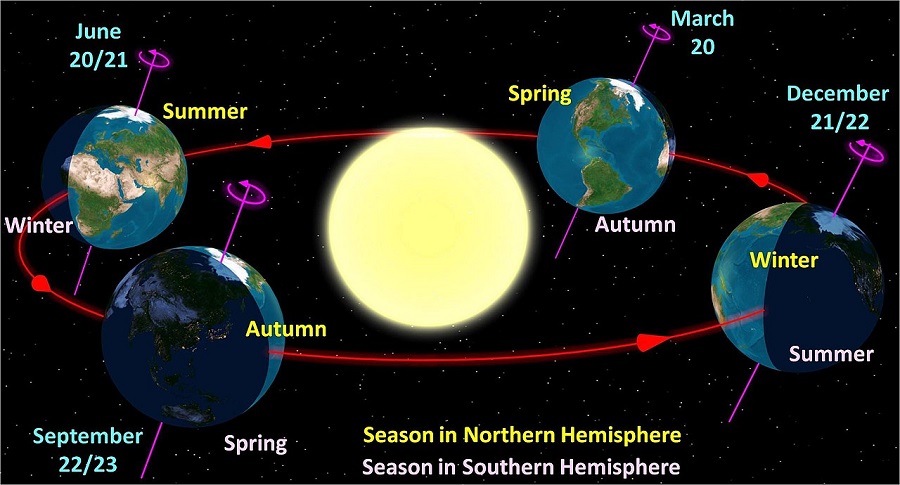Nearly every living being (whether human or lion or bacteria or ant) is aware of the fact that what season is? In fact, even if we just talk about humans only, a human being can divide one year up to four seasons such that: Summer, Autumn, Winter, and, Spring.
Moreover, we can also divide seasons in so many different ways. In India, according to Hindu Calendar, a year is divided into six seasons or (Ritu) such that each season has a fixed 2-month time span of the 12-Month Hindu Calendar.
According to the Hindu Calendar, the six seasons or Ritu are Vasanta (spring), Greeshma (summer), Varsha (monsoon), Sharad (spring), Hemanta (early winter), and Shishira (prevernal or late winter).
What Causes the Seasons on Earth?
In a modern world, everyone is quite aware of the fact that according to Johannes Kepler Heliocentric Model, the earth revolves around the sun in an elliptical orbit. Therefore, as a result, one might assume that our planet’s changing distance from the sun could be the reason for the season on earth.
But, sadly, it is not the correct explanation for the reason for the change in the seasons. No wonder, it does have some effects on different seasons on earth. But, could not completely justify the exact reason for the season on Earth.
Earth’s Axial Tilt is the Reason for the Season on Earth

Well, the actual reason for the season on earth is Earth’s Axial tilt, relative to its orbital plane while traveling in an elliptical loop around the Sun.
In the astronomical world, the angle at which the earth is tilted is known as “Obliquity“. In addition, the angle of Earth’s axial tilt is approximately 23.4 degrees.
Why is the Earth Tilted?

The correct reason behind the Earth’s Tilt is still a puzzle to solve. In fact, there are so many controversial and hypothetical theories related to the Earth’s Axial Tilt. But, none of them is satisfactory.
One theory suggests that during the early age of the solar system when young-earth collided with some early heavenly body – a body which later became the natural satellite of planet Earth.
Therefore, as a result of that collision, there is an axial tilt on earth of 23.4 degrees. On the other hand, some scientists suggest that planet earth may have tilted itself to gain its ecological balance.
In my view, one mindful person can regard that both of the above theories are just theoretical. Because when that happened we were not there. Therefore, All we can do is argue!!
Editor’s Choice: Indeed, moon is moving away from earth, BUT WHY?
Who Discovered the Earth was Tilted?
The axial tilt of the earth is surprisingly known for a very long time. I mean, according to the historical scientific writings; the earth’s tilt had been logically calculated in Ancient India and China around 1100 BC.
Later, in 1437, Ulugh Beg of Samarkand, Uzbekistan who was an Astronomer, a mathematician confirmed the earth’s Obliquity as 23°30′17″ (23.5047°).
Moreover, later in the modern world, the first accurate calculation of the earth’s tilt was calculated by Danish Astronomer Tycho Brahe.
How the Seasons are Formed?

It is a world-recognized fact that is if we divide our sphere (planet earth) what we get is two hemispheres. These are commonly known as Northern Hemisphere and Southern Hemisphere.
Due to the cyclic rotation of the earth around the sun, the hemisphere tilted toward or away from the sun changes simultaneously.
June Solstice

Because of the cyclic rotation and, of course, the earth’s axial tilt, when there is a summer in the northern hemisphere. At the same time, there is a winter in the southern hemisphere. In other words, when the northern hemisphere is tilted toward the sun, it experiences a harsh summer.
Meaning, longer days shorter nights. On the other hand, at the same time, the southern hemisphere is experiencing winters. Meaning, shorter days longer nights.
Editor’s Choice: Seasons in Northern Hemisphere & its Bizarre Consequences
December Solstice

Similarly, when the northern hemisphere is tilted away from the sun, it experiences a hellish winter. Meaning, shorter days longer nights. On the flip side, the southern hemisphere is experiencing harsh summers. Meaning, longer days shorter nights.
In fact, just like the June and December Solstice, we can also categorize March and September Equinox with respect to the northern and southern hemisphere. Such that, when there is an arrival of Spring in the northern hemisphere (March), at the same time, there is an arrival of autumn in the southern hemisphere.
Editor’s Choice: Seasons in Southern Hemisphere & its Bizarre Consequences
As far as the equator is concerned; there is no change in the season. Because each day sunlight strikes the equator at the same angle. In other words; every day of the year, the equator receives 12 hours of sunlight.
That’s it for this post. If you like this article, share it if you like, like it if you share it. You can also find us on Mix, Twitter, Pinterest, and Facebook. Hey man, If you have come this far, do give us feedback in the comment section. It would make my day. You can also make a donation. Your donations will help us to run our website and serve you BETTER. Cheers!!!
You might also like:
- March Equinox 2022 – First Day of Spring in Northern Hemisphere
- March Equinox 2022 – First Day of Fall in Southern Hemisphere
- June Solstice 2022 – First Day of Summer in Northern Hemisphere
- June Solstice 2022 – First Day of Winter in Southern Hemisphere
- September Equinox 2022 – First Day of Fall in Northern Hemisphere
- September Equinox 2022 – First Day of Spring in Southern Hemisphere
- December Solstice 2022 – First Day of Winter in Northern Hemisphere
- December Solstice 2022 – First Day of Summer in Southern Hemisphere
